The future of M.2 SSDs is just as good for your new gaming machine as it is for a sluggish old computer. Discover our selection of the best models on the market to give your computer a boost.
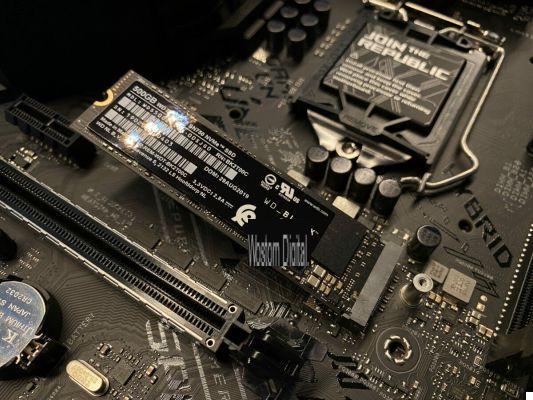
An M.2 NVMe SSD being installed on a motherboard
The best M.2 SSDs of the moment:
- The best: Samsung 980 Pro
- Coolest: Corsair MP600
- The safe bet: Samsung 970 Evo Plus
- Good value for money: Crucial P2
- The low price: PNY XLR8 CS3030
SSDs are now more and more accessible and have become essential in our computers. Today it is very rare to find a computer that does not have at least one SSD for the operating system. With the development of this technology, there are many references on the market and it is easy to get lost.
If the SSDs were originally limited to a 2,5-inch format, the market is now turning a lot to the M.2 format, more compact and easier to install. In the form of a small card that slides onto the motherboard, M.2 SSDs typically enjoy higher performance than their 2,5-inch counterparts and do not require any power cables or cables. data since everything is provided by the M.2 connection.
After a rise linked to cryptocurrencies like Chia which use storage for their calculations, SSD prices have recently started to drop again, so now is a good time to equip yourself. We do not know when the next fluctuation will occur.
You will find in this buying guide, different references for all budgets and depending on your use. And if you have any questions about SSDs, you'll certainly find an answer at the bottom of this article, in our FAQ.
Need an SSD for your PlayStation 5? We have listed the PS5 compatible SSDs for you and made an installation guide! To help you design your PC, we also redirect you to the other component purchasing guides:
- Guide to the best processors
- Guide to the best coolers
- Guide to the best graphics cards
- Guides to the best power supplies
- Guides to the best NVME SSDs
- Guide to the best boxes
Samsung 980 Pro : simply the best
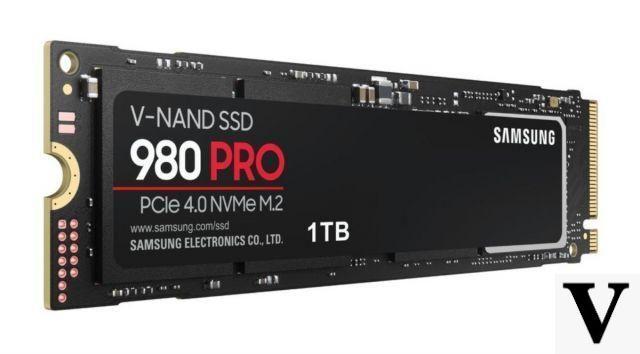
The Korean giant has been the undisputed leader in the high-end SSD market for several years. The brand had however taken its time to switch to PCIe 4.0; it is now done with this 980 Pro. Available in capacities ranging from 250 GB to 2 TB it is built around TLC memory.
First observation: the speeds pulverize all the other general public disks, with nearly 7,1 Gb / s in reading and 5,2 Gb / s in writing. If the performance is good, consumption is however high and the disc heats up quickly. We therefore strongly recommend that you install it under a heatsink, whether it is supplied with your motherboard or sold separately.
These exceptional performances also come at a high price, so we hope that Samsung will quickly release a more affordable EVO version.
The Samsung 980 Pro at a glance:
- Read / write speed: 7,1 GB / s - 5,2 GB / s (1 TB and 2 TB versions)
- TLC memory
- Quite simply the fastest on the market
Buy the Samsung 980 Pro SSD:
- 500 GB model: available for around 115 euros
- 1TB model: available for around 183 euros
- 2TB model: available for around 388 euros
Corsair MP600: pass the fourth
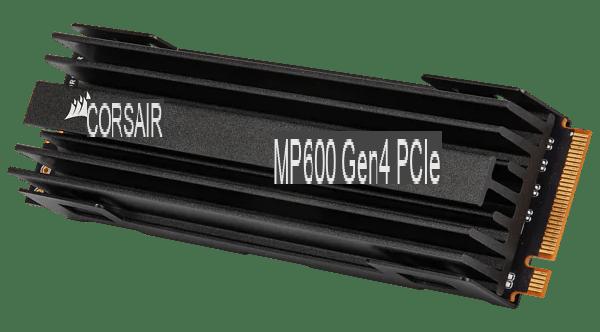
If you have an unlimited budget and don't want to make any concessions when it comes to your M.2 SSD, you can definitely turn to the Corsair MP600. It is quite simply one of the fastest SSDs on the market since it takes advantage of its compatibility with the PCIe 4.0 standard (compatible motherboard essential).
It is equipped with TLC memory and is available in 500 GB, 1 TB or 2 TB for a price that is finally quite affordable. Corsair had the good idea to graft it with a fairly large heat sink which will guarantee it effective cooling to withstand the most intense uses. Be careful though, this can prevent it from being installed in certain locations (on the back of a motherboard for example) or in a laptop PC.
The Corsair MP600 at a glance:
- Read / write speed: 4,95 GB / s - 4,25 GB / s (1 TB and 2 TB versions)
- TLC memory
- Integrated heat sink
Buy the Corsair MP600 SSD:
- 500 GB model: available for around 107 euros
- 1TB model: available for around 145 euros
- 2TB model: available for around 340 euros
Samsung 970 EVO Plus: the classic
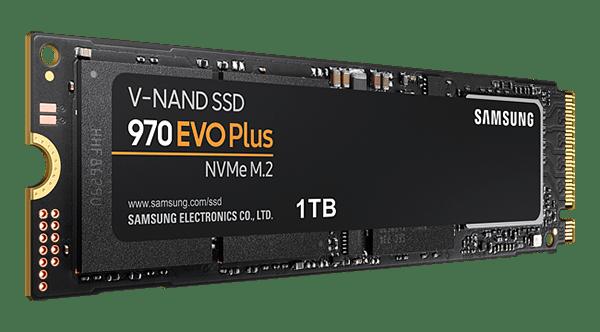
When it comes to SSDs, Samsung has almost always offered very convincing models. The 970 EVO Plus are no exception and offer excellent flow rates in all situations while being particularly enduring. If you are looking for a versatile NVMe SSD with solid performance, this is the choice of reason.
These SSDs offer speeds of 3,5 GB / s in reading and up to 3,3 GB / s in writing for the 1 TB versions. Due to their performance and Samsung's mastery in this sector, the prices of these models are therefore slightly superior to those of their competitors.
The Samsung 970 EVO plus at a glance:
- Read / write speed: 3,5 Gb / s - 3,3 Gb / s (1TB and 2TB version)
- TLC memory
- The benchmark for all uses
Buy the Samsung 970 EVO Plus SSD:
- 500 GB model: available for around 85 euros
- 1TB model: available for around 136 euros
- 2TB model: available for around 251 euros
Crucial P2: the convincing entry level
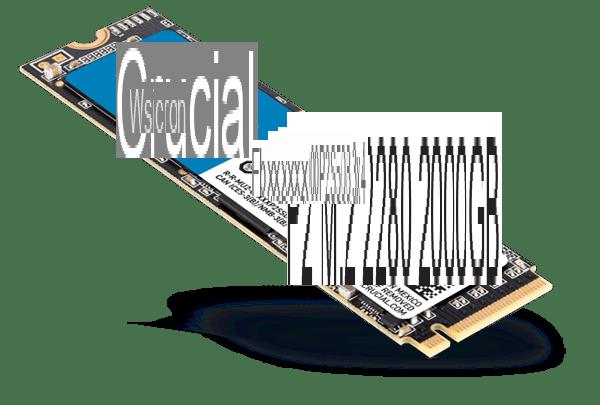
Crucial has been well positioned at the entry level for several years now. We think in particular of the Crucial P2 M.1 SSDs which offered a convincing service for an attractive price. The brand has taken this same recipe out of the closet to offer the NVMe Crucial P2 SSDs which are very interesting and efficient.
Equipped with TLC memory and available in 250 GB, 500 GB, 1 TB and 2 TB versions, they offer read speeds of up to 2,4 GB / s and almost 2 GB / s write for models with the more storage (1 and 2 TB).
The Crucial P2 in brief:
- Read / write speed: 2,4 Gb / s - 1,9 Gb / s (2TB version)
- TLC memory
- Accessible and often on sale
Buy the Crucial P2 SSD:
- 500 GB model: available for around 52 euros
- 1TB model: available for around 89 euros
- 2TB model: available for around 200 euros
PNY XLR8 CS3030: the affordable alternative
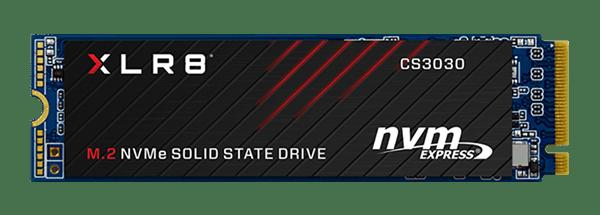
The NVMe PNY XLR8 CS3030 SSDs present themselves as convincing and powerful alternatives to the classic Crucial P2. Also benefiting from a TLC memory, they offer higher performance than P2 for a slightly higher price.
In terms of speed, you will enjoy here 3,5 Gb / s in reading and up to 3 Gb / s in writing. This reference is therefore positioned as efficient and accessible and will therefore suit the majority of needs. Too bad, however, that PNY has recently reduced its stamina to counter demand from cryptocurrency miners.
The PNY XLR8 CS3030 at a glance:
- Read / write speed: 3,5 Gb / s - 3 Gb / s (1TB and 2TB versions)
- TLC memory
- Efficient and accessible
Acheter le SSD PNY XLR8 CS3030:
- 500 GB model: available for around 65 euros
- 1TB model: available for around 115 euros
- 2TB model: available for around 267 euros
All about M2 SSDs
What is an SSD?
You are certainly familiar with hard disks, which have been used in our computers for several decades now. If the latter are now proven and offer ever larger storage capacities, they unfortunately remain limited in terms of performance. As a reminder, the latter operate in a “mechanical” manner with high-speed rotating platters traversed by read / write heads.
SSDs use NAND, a type of flash memory that provides superior performance while being in general more compact than our conventional hard drives. SSDs (and M.2 SSDs) are actually large USB drives since they use the same type of memory as the latter.
In comparison, hard disks offer, at the same price, more storage space than SSDs and are more suitable than the latter for long-term data storage. Conversely, SSDs are less durable, but much more efficient than a hard drive to accommodate your operating system and your games, for example.
We therefore recommend in general to use an SSD for the operating system and the most demanding games and to add a hard drive, with more space to store your documents, media and other data that do not have need to be accessible very quickly.
Is my PC compatible and how do I install an M.2 SSD?
An M.2 SSD is installed, as its name suggests, on an M.2 connector and therefore, directly on the motherboard of your computer. All recent cards are equipped with this connection and you just have to consult the manual of the latter to verify the presence of this port and its compatibility with the NVMe standard allowing to obtain the best performances.
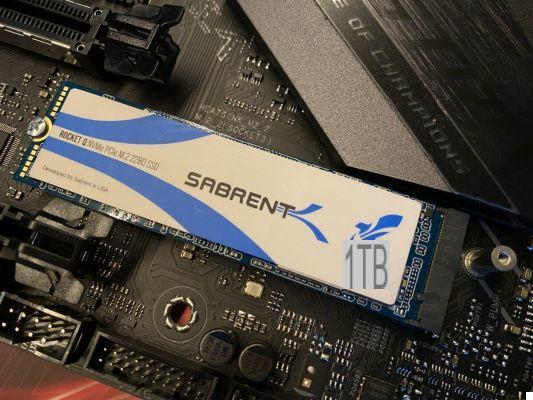
You have to enter the M.2 SSD at an angle then add a screw to keep it flat
For installation, simply locate the M.2 connector, remove the fixing screw and / or any heat sink. Then install the drive in the connector and secure parallel to the board using the screw and / or heat sink. If your card is equipped with such a device, remember to remove the protective plastic present on the thermal paste normally present under the heatsink.
SLC, MLC, TLC, QLC: what are the different types of memory?
By browsing the SSD data sheets, you have undoubtedly noticed that for each reference, the type of flash memory used is specified. There are currently 4 main types on the different SSDs on the market which directly influence the performance of SSDs. This list is ordered from the most efficient and durable (and more expensive) to the least efficient and sustainable (and therefore less expensive):
- SLC (Single Level Cell): each cell can store a single bit. It is the most expensive memory which is generally intended for professional applications. It is also the most efficient and durable memory with several tens of thousands of write cycles.
- MLC (Multi Level Cell): each cell can store several bits (generally 2). Performance is lower than SLC memory, and lifespan does not exceed 10 cycles.
- TLC (Triple Level Cell): each cell can store 3 bits. This type of memory is less efficient and less enduring than the previous two with around 1000 write cycles.
- QLC (Quad Level Cell): each cell can store 4 bits. The most recent technology, they offer performance below TLC memory, but its low cost allows you to take advantage of more storage capacity.
To overcome the performance problems of less expensive memories, manufacturers often use a more efficient cache memory. Thus, on small operations, SSDs equipped with an SLC cache memory (for example) will benefit from very decent performance. We discuss this a little later on this page.
I don't have enough M.2 slots on my motherboard, what should I do?
Apart from a few ultra high-end motherboards, the vast majority of PCs only have two NVME slots. However, it is possible to add more via PCI Express expansion cards. A basic model that can accommodate a PCI Express 3.0 costs only about twenty euros. For a hundred euros, there are models capable of 4 slots wired in PCI Express 4.0. Enough to stock up on ultra-fast storage without breaking the bank.
SATA or NVMe, what are the differences?
There are two main "types" of M.2 SSDs: those compatible with SATA (AHCI protocol) and those compatible with PCI Express (NVMe protocol). These two standards are not necessarily dependent on the connection, but define the bus used by the system to access the storage. To explain things simply, it should be understood that the SATA (Serial ATA) standard was originally created for hard drives and other optical drives whose speeds were not the same as those of our SSDs.
Thus, the SATA standard peaks in its version 3 at 600 MB / s. You could use the strongest SSD on the market, it could not exceed this speed if you use it in SATA. The NVMe (Non-Volatile Memory Express) standard was specifically designed for flash memory drives and uses the much higher performance PCI Express bus.
Most M.2 SSDs sold on the market are now NVMe branded and, similarly, the vast majority of recent motherboards are compatible with these drives. Thanks to this, you will be able to obtain speeds of several GB / s.
What are the maximum speeds that I can achieve?
We talk a lot about M.2 SSD bitrates in these lines. This is certainly one of the most important features when choosing your new drive, but you should be careful about the data given by the manufacturers.
Indeed, very often, these flow rates are obtained under optimal conditions and several factors can affect performance. We have seen that the type of memory used is important and that it partly defines the performance of the disk. QLC memory drives are starting to come in droves on the market and this memory does not offer exemplary performance. This is why manufacturers add a cache whose size may vary depending on the model.
This cache, made up of more efficient memory, will improve reading and writing speeds as long as it is not full. This method will prove to be very effective for occasional and light accesses, but will unfortunately not be sufficient when transferring very large files which will involve a significant drop in performance. Nothing prohibitive however if you use your disc in a "normal" way.
Another point to take into account: the recooling. This point joins the previous one since this behavior will be more inclined to appear in the case of a very intensive use of your disk. Just like a processor, an M.2 SSD must maintain the correct temperature to function under good conditions. Therefore, if your disk is not well cooled, its performance can collapse on very important transfers so that the whole can remain at the correct temperature. You will also notice that on some motherboards, heat sinks are present on the M.2 slots.
When installing your M.2 SSD and while copying all your games and files to it, don't worry about not getting the speeds indicated on the box. This is "normal" and totally dependent on the technical characteristics of your SSD.
Do I have to buy a PCI-Express 4.0 compatible SSD?
For a few months now, new M.2 SSDs compatible with the PCIe 4.0 come onto the market. First reserved for AMD Ryzen 3000 processors and B550 and X570 chipsets, the standard is now available from Intel. For this, you will need an 11th generation processor coupled with a B560 or Z590 chipset. The use of PCIe 4.0 allows these disks to achieve performance never before achieved with speeds of up to 5 GB / s in writing.
While these figures are impressive on paper, in practice they currently do not have much interest and can only be achieved under optimal conditions. On the other hand, an M.2 PCIe 4.0 SSD will offer better performance than a PCIe 3.0 disk if it is installed on a PCIe 3.0 motherboard. The purchase is therefore not necessarily unnecessary if you plan to keep it for several years, the time that real uses develop.
For standard use, whether in office or gaming, PCI-Express 4.0 SSDs are therefore not really of interest today. Certain specific application uses could nevertheless benefit from it in the future. Likewise, do not expect to transfer files at 5 Gb / s between two PCIe 4.0 SSDs or with any other device since no connection except Thunderbolt 3 can, theoretically, keep up with these high speeds.
Can I install an M.2 SSD in my PlayStation 5?
If the M.2 slot was present from the release of the PlayStation 5, it took Sony over a year to finally be usable. A system update eagerly awaited by gamers, especially those with a Digital version of the console.
To add more storage, you will have to start by choosing one of the SSDs compatible with the PS5, then follow our update guide. No worries, the operation only requires a screwdriver and takes no more than 5 minutes!
SSD and video games, what are the advantages?
Compared to a classic hard drive, an SSD will not give you a real performance gain. So don't expect to significantly increase the number of frames per second in your favorite games. The processor and graphics card are much more important here and will have a real impact on performance.
On the other hand, thanks to its reduced access times and the better speeds it offers, the SSD will very significantly reduce loading times. Thus, all games will benefit from faster start-up and faster loads. Some very demanding titles (mainly open worlds) will also benefit from a more “fluid” experience. The use of ultra-fast SSDs on the PS5 and Xbox Series has opened the door to better use of SSDs in games, for example with almost no load times.


























